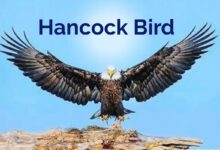
The animal kingdom is rich with fascinating species, and birds are among the most intriguing due to their diversity, behaviors, and unique characteristics. One such bird that has captured the attention of many birdwatchers and wildlife enthusiasts is the Hancock bird. This elusive and lesser-known bird is not only admired for its striking appearance but also for its unique behaviors and ecological significance. In this comprehensive article, we will explore the world of the Hancock bird, offering detailed insights into its identification, habitat, diet, breeding patterns, and more.
What is the Hancock Bird?
The Hancock bird, while not as widely known as other species, is a marvel in the world of avian wildlife. Although specific characteristics of this bird may vary depending on its geographical distribution, the Hancock bird is generally recognized for its medium size and distinctive plumage. Its sleek, often dark-colored feathers make it easily distinguishable from other birds in its habitat.
Interestingly, the Hancock bird is known for its agile flying capabilities. These birds are adept at maneuvering through various terrains, from dense forests to open grasslands. They are generally solitary creatures, though they occasionally gather in small flocks during migration or breeding seasons. Observing a Hancock bird in flight is a treat for any birdwatcher due to its grace and precision.
Where Can You Find the Hancock Bird? (Habitat and Distribution)
The Hancock bird’s habitat is as diverse as the bird itself. While some species are native to certain regions, the Hancock bird has a broad distribution. They are often found in temperate climates, thriving in areas that provide a rich supply of food and safe nesting spots. These birds prefer environments with ample tree cover, such as woodlands, forests, and even mountainous regions. However, they are also known to frequent wetlands and coastal areas during migration seasons.
One notable feature of the Hancock bird’s habitat is its adaptability. While they thrive in natural environments, they are also found near human settlements, where food sources might be more abundant. Gardens, parks, and urban areas sometimes provide the resources these birds need, such as insects, seeds, and fruits. This adaptability is a significant reason why the Hancock bird continues to thrive, even in regions where natural habitats are shrinking due to urban development.
How to Identify a Hancock Bird
Identifying a Hancock bird requires attention to several key features. The bird’s plumage is one of its most distinct identifiers. Hancock birds typically exhibit dark feathers, ranging from deep browns to jet blacks, with occasional lighter markings around their wings and tail. Their size varies but is usually medium compared to other birds in their environment, making them easy to spot in the wild.
Apart from their physical appearance, Hancock birds are also known for their distinctive calls. Their vocalizations are sharp and piercing, often heard during the early morning or late evening. These calls are used for communication, both for attracting mates and signaling danger to other birds.
Another characteristic that sets the Hancock bird apart is its flight pattern. These birds have a smooth and agile flying style, often gliding through the air before making quick, darting movements. This flight pattern, combined with their vocalizations and plumage, makes the Hancock bird relatively easy to identify for those familiar with birdwatching techniques.
The Diet of the Hancock Bird
Like many bird species, the diet of the Hancock bird is both diverse and dependent on its habitat. These birds are primarily insectivorous, feasting on a wide variety of insects, including beetles, caterpillars, and ants. Their sharp beaks are well-adapted for catching and consuming these small creatures, and their excellent vision allows them to spot prey from a distance.
However, the Hancock bird’s diet is not limited to insects. In some regions, these birds are known to consume small fruits, seeds, and even small mammals or reptiles. During the colder months, when insects are less abundant, Hancock birds often turn to berries and seeds to sustain themselves. Their ability to adapt their diet based on seasonal changes is one of the reasons they have been able to survive in a variety of environments.
In urban areas, Hancock birds have been observed scavenging for food, often picking at scraps left by humans. While this may seem unusual, it highlights their opportunistic feeding habits and their ability to thrive in diverse settings.
Breeding Habits and Nesting of Hancock Birds
Breeding season for Hancock birds typically begins in the spring and extends into the summer months. These birds are monogamous, forming long-term pair bonds that last throughout the breeding season, and in some cases, for several years. Courtship displays are a common sight during this time, with males engaging in elaborate dances and vocalizations to attract potential mates.
Once a pair bond is formed, the female Hancock bird selects a suitable nesting site. These nests are often built in the crooks of trees or dense shrubs, providing a safe environment for the eggs. The nest is constructed from twigs, leaves, and other plant materials, with both the male and female contributing to its construction.
The female typically lays between 2 to 5 eggs, which are incubated for approximately two weeks. During this period, both parents take turns guarding the nest and foraging for food. Once the chicks hatch, they are entirely dependent on their parents for food and protection. The parents feed the chicks a diet rich in insects, ensuring they grow quickly and are ready to leave the nest within a few weeks.
The Role of the Hancock Bird in the Ecosystem
Every species plays a vital role in its ecosystem, and the Hancock bird is no exception. These birds are essential for controlling insect populations, particularly in areas where insects might otherwise become pests. By preying on insects such as beetles, caterpillars, and other small creatures, Hancock birds help maintain the balance of their habitats.
Additionally, Hancock birds contribute to seed dispersal. When they consume fruits and berries, they often spread the seeds through their droppings, aiding in plant reproduction. This seed dispersal helps maintain healthy plant populations, which in turn supports other wildlife in the ecosystem.
The presence of Hancock birds can also indicate the overall health of an environment. Areas that support these birds are often rich in biodiversity and have abundant food sources, clean water, and safe nesting sites. As such, birdwatchers and conservationists often use the Hancock bird as a marker for environmental quality.
Threats Facing the Hancock Bird
Despite their adaptability, Hancock birds face several threats in the wild. One of the most significant threats is habitat loss. As human populations expand, natural habitats are often cleared for agriculture, urban development, and infrastructure projects. This loss of habitat can make it difficult for Hancock birds to find suitable nesting sites and food sources, particularly in areas that have been heavily impacted by deforestation.
Climate change is another pressing concern for the Hancock bird. As temperatures rise and weather patterns shift, these birds may struggle to adapt to the changing conditions. For instance, a shift in temperature could affect the availability of food sources, forcing birds to migrate to new areas in search of sustenance.
Additionally, the use of pesticides in agricultural areas poses a significant threat to the Hancock bird’s food supply. Pesticides can reduce insect populations, which are a primary food source for these birds. Ingesting pesticide-contaminated insects can also harm the birds directly, leading to illness or death.
Conservation Efforts for the Hancock Bird
Conservationists around the world are working to protect the Hancock bird and ensure its survival for future generations. One of the primary goals of these conservation efforts is habitat preservation. By protecting and restoring natural habitats, conservationists can provide the Hancock bird with the resources it needs to thrive.
Protected areas, such as wildlife reserves and national parks, play a crucial role in these efforts. These areas offer a safe haven for Hancock birds, free from the pressures of habitat destruction and human interference. Conservationists are also working with local communities to promote sustainable land-use practices, which help protect the Hancock bird’s habitat while also supporting human livelihoods.
Education and awareness campaigns are another essential component of Hancock bird conservation. By educating the public about the importance of these birds and the threats they face, conservationists hope to inspire greater appreciation and support for their protection.
How to Observe and Appreciate Hancock Birds in the Wild
For birdwatchers and nature enthusiasts, observing a Hancock bird in its natural habitat can be a thrilling experience. To increase your chances of spotting one of these elusive creatures, it is essential to know where to look and what to listen for.
Early morning or late evening are the best times for birdwatching, as Hancock birds are most active during these periods. Bring a pair of binoculars and a field guide to help identify the bird from a distance. Listening for the bird’s distinctive call is another useful technique, as their sharp, piercing vocalizations can often be heard before the bird is seen.
When observing Hancock birds, it is crucial to maintain a respectful distance. Approaching too closely can disturb the bird, particularly during breeding season when they are protecting their nests. By practicing responsible birdwatching, you can enjoy the beauty of the Hancock bird while also contributing to its conservation.
Read More: Unveiling the World of Agrawau: Pearls of wisdom which are worth finding
Conclusion: The Importance of Protecting the Hancock Bird
The Hancock bird is a remarkable species that plays a vital role in its ecosystem. Its unique behaviors, adaptability, and ecological significance make it a species worth studying and protecting. However, like many wildlife species, the Hancock bird faces numerous threats, from habitat loss to climate change. By supporting conservation efforts and practicing responsible birdwatching, we can help ensure that the Hancock bird continues to thrive in the wild for generations to come.
Whether you are a seasoned birdwatcher or a nature enthusiast just beginning to explore the world of birds, the Hancock bird is a species that will undoubtedly capture your interest. With its distinctive appearance, agile flight, and fascinating behaviors, the Hancock bird serves as a reminder of the incredible diversity and beauty of the natural world.
